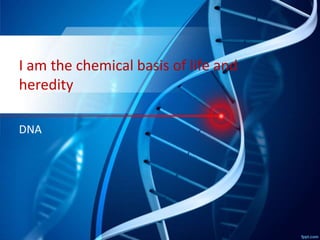
Genetices
- 1. I am the chemical basis of life and heredity DNA
- 2. DNA structure: • DNA is a polymer of deoxyribonucleoside monophosphates covalently linked by 3´-5´ phosphodiester bond. With the exception a few virus that contain single stranded (ss). • DNA exists as a double strands wind around each other forming a double helix. • Nucleic acids (DNA & RNA) are require for storage and expression of genetic information. DNA is the repository of genetic information present in the chromosomes in the nucleus of eukaryotic organism.
- 3. Central dogma of life/molecular biology • The flow of information from DNA to RNA to protein is termed the “central dogma” of life or molecular biology. This is descriptive of all organisms with the exception of some viruses that have RNA as the repository of their genetic information.
- 4. Structure of DNA • Polymer of deoxyribonucleoside monophosphate covalently linked by 3´-5´ phosphodiester bond. DNA is found associated with various protein known as nucleoprotein present in the nucleus • DNA chain with the nucleotide sequence written in the 5´-3´ and another 3´-5´ direction. • DNA chain is more stylized form as sugar (ribose)- phosphate backbone.
- 5. 3´-5´ phosphodiester bonds • Phosphodiester bonds join the 3´-hydroxyl group of the deoxypentose of one nucleotide to the 5´-hydroxyl group of the deoxypentose of adjacent nucleotide through a phosphate bond. The resulting long unbranched chain chain has polarity with both a 5´ end (free end with a free phosphate) & 3´ end with a free hydroxyl group –that are not attached to other nucleotides. • The bases located along the resulting deoxyribose- phosphate backbone are always written in sequence from the 5´-end of the chain to the 3´-end, (5´-TACGTA-3´).
- 6. • Phosohodiester linkage between nucleotides (in DNA or RNA) can be cleaved hydrolytically by chemicals or hydrolyzed enzymatically by a family nucleases deoxyribonucleases for DNA and ribonucleases for RNA • ** only RNA is cleaved by alkali.
- 7. Double helix • In the double helix the two chains are coiled around a common axis called the axis of symmetry. The chains are paired in an antiparallel manner- that 5´ end of one strand is paired with 3´ end of the other strand. • In the DNA helix, the hydrophilic deoxyribose phosphate backbone of each chain is on the outside of the molecule, whereas the hydrophobic bases are stacked inside. The overall structure resembles a twisted ladder. The spatial relationship between two strands relationship between two strands in the helix creates major and minor groove. • This groove are the binding site for regulatory protein and certain anticancer drug e.g. actinomycin
- 8. Base pairing • The bases of one stand of DNA always bind with the bases of the second strand. Adenine always binds with thymine and cytosine with guanine. • Chargaff rule: in any sample of dsDNA the amount of adenine equals to the amount of thymine and the cytosine equals to guanine and the total amount of purines are equals to the total amount of pyrimidines. • The base pair are held together by hydrogen bond. Two hydrogen bond between A & T, and three hydrogen bond between C & G. This hydrophobic interaction stabilize the structure the double helix.
- 9. Separation of two DNA strand in the double helix • The two strands of the double helix separate when hydrogen bonds between the paired bases are disrupted. • Disruption can occur in the laboratory by altered pH of the solution, or by heating. • DNA is heated, the temperature at which one half of the helical structure is lost is defined as melting structure, the loss of helical structure in DNA is called denaturation, can be monitored by measuring its absorbance at 260 nm.
- 10. Structural form the double helix • There are three major structural forms of DNA- • B form described by watson and crick & right handed helix. • A form produced by moderate dehydration from B form & right handed helix • Z /zigzags form is left handed helix • Transition between B and Z forms may play a role in regulating gene expression.